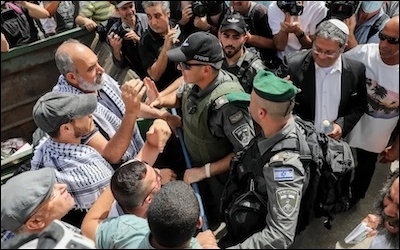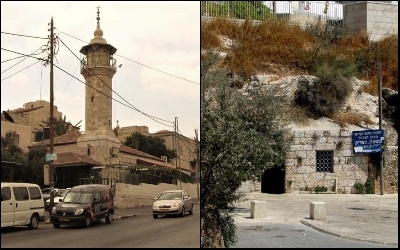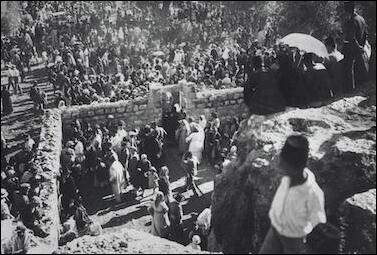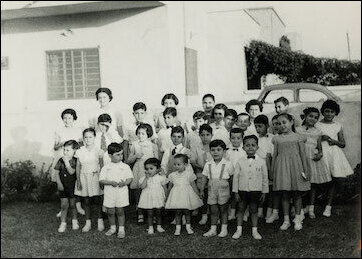by Jonathan Spyer
The Arab families recognized Jewish ownership of their residences.
Originally published under the title "Sheikh Jarrah, Shimon Hatzadik: A Tale of Two Gravesites in Jerusalem."
 Israeli security forces clash with protesters in the east Jerusalem neighborhood of Sheikh Jarrah on May 10, 2021. (Flash90) |
The current conflicts in Jerusalem are not traceable to a single source. The always charged period of Ramadan, the cancellation of Palestinian elections, the attacks on ultra-Orthodox Jews and the response to these by Jewish far-right activists, the placing of barriers at the Damascus Gate, and the frustrations born of a year of lockdowns are all important contributory factors.
The long dispute over housing rights in the neighborhood of Sheikh Jarrah, however, forms a prominent ingredient in the incendiary mix. The Supreme Court this week was due to rule on the appeal of three Arab families seeking the overturning of an eviction order against them. The ruling has now been postponed.
What is the background to this "real estate dispute between two private parties," as the Foreign Ministry website refers to it? And why has "Sheikh Jarrah" become a rallying cry for Arabs and their supporters both in Jerusalem and with echoes far beyond it?
Background
First, the origins: the current dispute surrounding the Sheikh Jarrah area has deep roots, stretching back to the first years of Arab and Jewish settlement outside the walls of Jerusalem's Old City, in the last decades of the 19th century.
The neighborhood of Sheikh Jarrah is named after Hussam al-Din al-Jarrahi, the personal physician of Saladin, vanquisher of the Crusaders.
Jarrahi's grave is located in the neighborhood, which contains also a Sufi shrine to him. The first private houses began to be built in the vicinity of the shrine during the latter third of the 19th century.
Rabah al-Husseini, a scion of the prominent Husseini family, built one of the first dwellings in what was to become Sheikh Jarrah, in 1865. This building is today the location of the American Colony Hotel. Additional members of the family followed him to the area, building houses of their own, and for a time the emergent neighborhood was particularly associated with the Husseinis. Other Arab notables, including members of the rival Nashashibi family, also moved in as Sheikh Jarrah developed.
 The gravesites of Hussam al-Din al-Jarrahi (left) and Shimon Hatzadik (right) |
The Jewish neighborhoods of Shimon Hatzadik and Nahalat Shimon developed coterminously with the Husseini area. The presence, similarly, of a venerated gravesite served as the force of attraction. The gravesite of Shimon Hatzadik, a prominent high priest of the Second Temple period, was in 1876 purchased by two Jewish trusts committed to the development of the Jewish population of Jerusalem. These were the Sephardi Community Council and the (Ashkenazi) General Council of the Congregation of Israel.
The cornerstone for the construction of the Shimon Hatzadik neighborhood was laid in 1890. Construction of neighboring Nahalat Shimon began in 1891. A few dozen Jewish families subsequently took up residence in the area.
These neighborhoods, in contrast to Sheikh Jarrah, were characterized by poverty, difficult conditions and overcrowding.
 Jews make their way to the tomb of Shimon Hatzadik in 1927. |
In 1948, as the British-officered Transjordanian Arab Legion advanced through eastern Jerusalem, the Hagana called on the residents of the Nahalat Shimon and Shimon Hatzadik neighborhoods to leave their homes for safer refuge in the majority Jewish west of the city. As seen in the Jewish Quarter of the Old City, it was the practice of the Legion to expel Jewish populations in their entirety from areas it conquered. The residents of Shimon Hatzadik duly fled their homes, and the areas subsequently lay abandoned.
In 1956, the government of Jordan, in cooperation with the United Nations Relief Works Association, arranged for the housing of 28 Palestinian refugee families in the area of the abandoned residential compounds in the Shimon Hatzadik neighborhood. The families leased the apartments subsequently built from the government of Jordan, paying a nominal rent.
The Return of Jewish Properties
In the Six Day War of 1967, the entirety of Jerusalem, including Sheikh Jarrah and the area of the Shimon Hatzadik and Nahalat Shimon neighborhoods, came under the control and jurisdiction of Israel. The properties in this area, including the compound where the refugees and their descendants were dwelling, were transferred to the administrator-general in the Justice Ministry.
The Jewish organizations responsible for the original purchase began proceedings for the return of the areas to them. In 1972, their claims were accepted, and ownership of the areas was transferred to them and recorded in the Land Registry.
The Arab families recognized Jewish ownership of their residences. |
In 1982, the two Jewish trusts sought the removal from their property of 23 Arab families that had remained resident in the Shimon Hatzadik area. An agreement was reached, according to which the Arab families recognized the ownership of the trusts, and in return received the status of protected tenants. The agreement was afforded the status of a court ruling, and on the basis of it, the petition by the trusts to remove the families from their property was rejected. As part of the agreement, the families were afforded long-term rental rights, and undertook to pay rent to the owners and to maintain the apartments.
In practice, however, no rents were subsequently paid, and, according to the Jewish trusts, renovations and alterations to the buildings were made by the tenants without a permit. In addition, the trusts claimed, the tenants had damaged and sought to destroy structures of the old Jewish neighborhood, including the synagogue.
In 1993, the trusts initiated further legal proceedings to have the tenants removed because of nonpayment of rent. In 2001, the Jerusalem Magistrate's Court accepted the demand of the trusts.
A series of subsequent lawsuits have sought to ensure the expulsion of the non-rent-paying residents, many of whom have become entangled in the appeals process.
The two Jewish trusts subsequently sold their properties in the area to an organization called Nahalat Shimon International, which in 2008 presented a plan for the removal of the non-rent-paying families (now numbering around 500 people) and for the construction in the area of a Jewish neighborhood of 200 housing units.
Subsequently, four of the families were evicted (the al-Kurd, Ghawi, Hanun and Sabbagh families). Eviction notices have been issued for others, but these have not been implemented. An additional 13 households, numbering 300 people, face the prospect of eviction, once all legal avenues of appeal are exhausted.
The issue has returned to prominence in recent days because three families were due to have the Supreme Court rule on their petition of appeal this week. In the event of the Supreme Court dismissing their appeal, no further legal avenues will be available and the way will be cleared for their eviction.
For Palestinians and their supporters, the Sheikh Jarrah issue has become emblematic of what they regard as the built-in injustice of arrangements put in place by Israel following the 1948 and 1967 wars.
The Legal and Administrative Matters Law, passed in 1970, allows for Israeli property owners who owned properties that in 1948 were transferred to Jordanian control to claim them back from the Israeli administrator-general. Property abandoned by Palestinian Arabs in the 1948 war was transferred in its entirety to the Custodian of Absentee Property, in line with the Absentee Property Law of 1950. An amendment to the law allows Arab-Israeli citizens and residents of east Jerusalem to claim monetary compensation for properties transferred to the Custodian, on the basis of the properties' value on November 29, 1947. But no legal path for the restitution of properties exists.
Backers of the Jewish efforts to reclaim property in eastern Jerusalem, meanwhile, maintain that they are following existing legal means in an attempt to right an injustice – namely, the refusal of the protected tenants to pay rent, as required by law. They further assert that this process is being undertaken without reference to any other situation or larger political context.
These legal niceties aside, there is a harsher, less diplomatic reality which is the reason that many Israelis may feel few pangs of conscience with regard to events in Sheikh Jarrah.
Lost Properties and the Arab-Israeli Conflict
Legal discussions regarding restitution of properties lost in the course of the long conflict between Jews and Arabs tend to arise only on the side where Israel has the power.
Where Arab participant countries in the 1948 war had and have jurisdiction, the matter of any claims to properties lost in the 1948 war by Jews expelled from these areas is regarded as closed. With regard to properties lost by Jews to Arab states, the law is the familiar one of greater force. The states in question, all dictatorships, are not interested in discussing the rights and wrongs of the issue. They have the capacity to enforce this preference. Hence no such discussions take place.
 A Jewish school in Baghdad, 1959. Jewish property in Iraq was expropriated after the 1967 Six Day War. |
During the period of 1948-67, for example, when Jordan ruled east Jerusalem and the West Bank, no legal avenue for recompense was available to Jews who had lost property as a result of their expulsion by Jordanian forces. The combined value of lost Jewish-owned properties in the Arab world and Iran, according to an Israeli investigation carried out in 2019, may amount to $150 billion. But these properties, many of them owned by Jews expelled from Arab participant countries in the 1948 war such as Iraq, remain beyond the reach of their legal owners. No path for compensation is available. An Iraqi Jew seeking to petition, for example, the current government in Baghdad for compensation for loss of property incurred during the expulsion of Iraq's Jews in 1951 would rapidly discover the futility of any such effort. For anyone with knowledge of the Middle East, the very idea of such an attempt indeed sounds absurd.
From this point of view, the apparent imbalance thus reflects a larger balance. Where Israel is in control, the matter is subject to discussion, and necessarily imperfect but existing legal process. The tenants at Shimon Hatzadik, for example, may find it unfair or unjust that they are required to pay rent to the property's owners. But should they prove willing to do so, their residence rights will be protected by law. There is no reflection of this on the other side, where the automatic assumption of the absolute justice of the Arab Muslim position translates into a similarly automatic dismissal of any legal process for individuals associated with the enemy camp. This is the harsh, usually unstated accounting of ethno-religious conflict.
As to how the current round of dispute regarding Sheikh Jarrah will play out, Defense Minister Benny Gantz sought and has now achieved the postponement of the Supreme Court ruling this week. His reasoning, presumably, was that in an already very tense Jerusalem, the ruling, if the petition had been dismissed, would have had the effect of pouring petrol on flames. The issue thus continues to await resolution.
The Fight for Jerusalem's Future
More broadly, the dispute over Sheikh Jarrah reflects the fact that the city of Jerusalem remains the focal point for a historic and unresolved battle of wills between the Israeli-Jewish attempt to consolidate sovereignty and normalize the notion of a united city under Israeli rule, and the ongoing efforts of a variety of Arab Muslim (and Muslim but non-Arab) actors to halt and reverse this process.
The Nahalat Shimon International organization and others like it have their parallels and opposite numbers. The government of Turkey, in particular, is busy quietly seeking to grow its influence behind the scenes in Jerusalem. Operating through its TIKA development fund, and through local Muslim Brotherhood-associated bodies, Ankara is busy trying to strengthen and extend its own power, and the power of the Sunni political Islam that it favors, in Arab communities in Jerusalem. Similar funds and foundations are maintained and financed by Qatar, Morocco, Jordan and Saudi Arabia. Palestinian millionaires such as Munib al-Masri and the late Abd al-Majid Shuman have been active in efforts to purchase property and support construction for the Arabs in Jerusalem.
This silent war, which has continued for decades and is nowhere near conclusion, follows a grammar different from the normally accepted rules of sovereignty and legal and political norms. Existing balances of power are seen as fluid and temporary, subject to the exercise of the will.
The supporters and backers of the tenants in Sheikh Jarrah, and the forces that want to rebuild Shimon Hatzadik and Nahalat Shimon will continue their contest even when the current tense period in the city has passed. Indeed, one could argue that the very same elements that 150 years ago led to the establishment of distinctive and rival settlements around the graves of Shimon Hatzadik and Hussam al-Din al-Jarrahi remain present, and in conflict, in the city today.
Jonathan Spyer is a Ginsburg/Milstein Writing Fellow at the Middle East Forum and director of the Middle East Center for Reporting and Analysis.
Source: https://www.meforum.org/62343/sheikh-jarrah-shimon-hatzadik
No comments:
Post a Comment